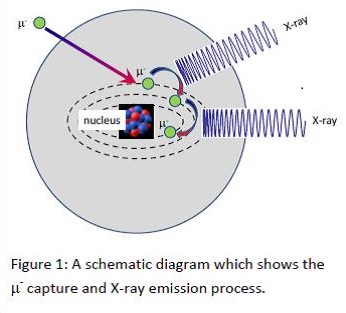Muon scientists, together with the Universities of Oxford and Warwick, are currently developing the technique on the RIKEN Port 4 to non-destructively probe the composition of archaeological objects – including gold and silver coins from the Roman period and the Mary Rose – paving the way for future studies on other archaeological artefacts, engineering samples, bio-systems, and battery materials.
Elemental analysis is a process in which the composition of a sample is determined. These techniques are often destructive and damaging, and therefore unsuitable for the analysis of valuable samples such as those used in engineering, and earth and archaeological sciences. Negative muons, on the other hand, can offer non-destructive multi-elemental analyses, based on the measurement of characteristic muonic X-rays emitted after the muon has been captured by the nuclei inside the sample (Figure 1).
Since the muon has a mass approximately 200 times that of an electron and orbits closer to the nucleus, the energy of a muonic X-ray transition is much greater than that of an electron transition. These high energy muonic X-rays (2 keV-10 MeV) are intense enough to pass through the sample material from the deep interior, without significant photon self-absorption, and can be easily detected by a semiconductor detector. The depth of muon implantation in the sample, and therefore depth of measurement, can be controlled by adjusting the incident muon momentum. Muons with high momenta (several 10s of MeV/c) have a relatively high permeability and this, combined with high energy muonic X-ray emissions, allows for investigation of elemental composition from micrometres to centimetres below the sample surface. Moreover, the sample is not activated by implanting muons.

Figure 1. Schematic showing µ- capture and X-ray emission process. Cascade transition of the trapped muon from higher to lower energy states occurs with emission of characteristic muonic X-rays.
The idea of using negative muons for chemical analysis was first suggested over 50 years ago, however, the technique has not been widely used due to the lack of a highly intense muon source. The intense pulsed muon source at ISIS has the capacity to generate a suitable negative muon beam with a momentum range of 20-90 MeV/c, meaning such analyses are now possible at the facility. Negative muons have been used in the past to investigate a range of materials including Japanese coins, spinal columns, pig fat, ancient Chinese mirrors and, more recently, meteorites.
Initial tests on Riken Port 4 reveal sensitivity of the technique to all elements, and that depth-dependant studies are possible. Controlling the muon momentum from 30-50 MeV/c successfully demonstrated a depth profile analysis of elements including iron, zinc, copper and silver from a layered sample several millimetres thick.
“This work will help develop better analytical protocols which will meet the increasingly stringent demands of non-destructive analysis, without the accompanying drawbacks of surface sensitivity, which can give misleading results,” says Mark Pollard, Professor of Archaeological Science at the University of Oxford.
Preliminary investigations on Roman coins dated 14 AD to 420 AD (Figure 2), reveal clear differences in their elemental compositions with varying proportions of gold, and further experiments are planned on a more extensive collection to offer insight into the circulation of gold around the Roman Empire.
“Knowing the composition of the Roman coins enables us to understand the economic climate and the variations over time in the exploitation of different mining territories,” says Andrew Wilson, Professor of the Archaeology of the Roman Empire, University of Oxford.
With the capabilities of bulk analysis of light to heavy elements without sample activation, elemental analysis using negative muons represents a unique analytical method, complementary to other non-destructive techniques, that can be used to investigate a vast range of materials. The next step is to incorporate rotation and tilt measurements to produce a three-dimensional map of the elemental composition of a sample.
“This technique is very powerful and allows bulk elemental analysis completely non-destructively and can be applied to any material, such as battery materials, archaeological artefacts, biological systems, engineering samples and so on, that require the composition to be known.” Dr Adrian Hillier, Instrument scientist and leader of the ISIS muon group.
Preeti Kaur
Research date: March 2015
Further Information
http://www.sciencedirect.com/science/article/pii/S0026265X1500301X
Hillier et al. (2016) Microchemical Journal 125, 203-207.
